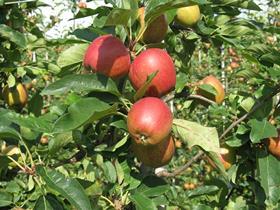
A new “early warning” method to help British growers identify the best Gala apples to pick for long-term storage could help reduce waste and grow sales.
The research, funded by AHDB Horticulture, was commissioned to help extend the market window for UK grown Gala apples beyond April, and could be available in a commercially viable device soon.
The device will give growers advance warning of when to harvest, seven to ten days earlier than the current method.
Scott Raffle, AHDB knowledge exchange manager, said: “While the current test for predicting the best harvest date is reliable, it offers very little advance notice for growers. We hope this research will lead to a commercially viable device that will mean growers can better mobilise staff and equipment to the right orchards, at the right time, for a more efficient harvest.”
Gala apples are currently picked for long-term storage when their starch levels decline to 80-75 per cent, measured by dipping cut-fruit in iodine. However, the decline in starch to this level can happen very rapidly over a few days, giving growers very little notice in which to prepare their harvest operation.
The new technique is non-destructive and measures the level of chlorophyll fluorescence, energy re-emitted when not absorbed by the plant during photosynthesis. This measurement tracks changes during fruit maturity.
Mehrdad Mirzaee, a researcher for the project at Landseer Ltd, said: “In order for UK growers to extend their market window, their produce must be comparable in terms of quality and price to imported options. The only way to do this is through attention to detail at harvest, to identify the right fruit that can be picked for long-term storage.”
Following the completion of the project in 2019, the next phase will be to develop a practical, applicable and affordable device for growers to use on their own farms.
Nigel Kitney, H L Hutchinson’s Ltd, industry representatives for the project, said: “Apple growers are facing increased demands for superior quality fruit while balancing the challenges of labour supply. Chlorophyll fluorescence helps assess an orchard’s suitability for long-term storage and gives a ten-day early warning that fruit will be ready to pick enabling improved efficiency of harvest organisation”
The AHDB said the technique could go on to be used on a range of fresh produce, helping reduce waste in the supply chain by better predicting when to harvest.



